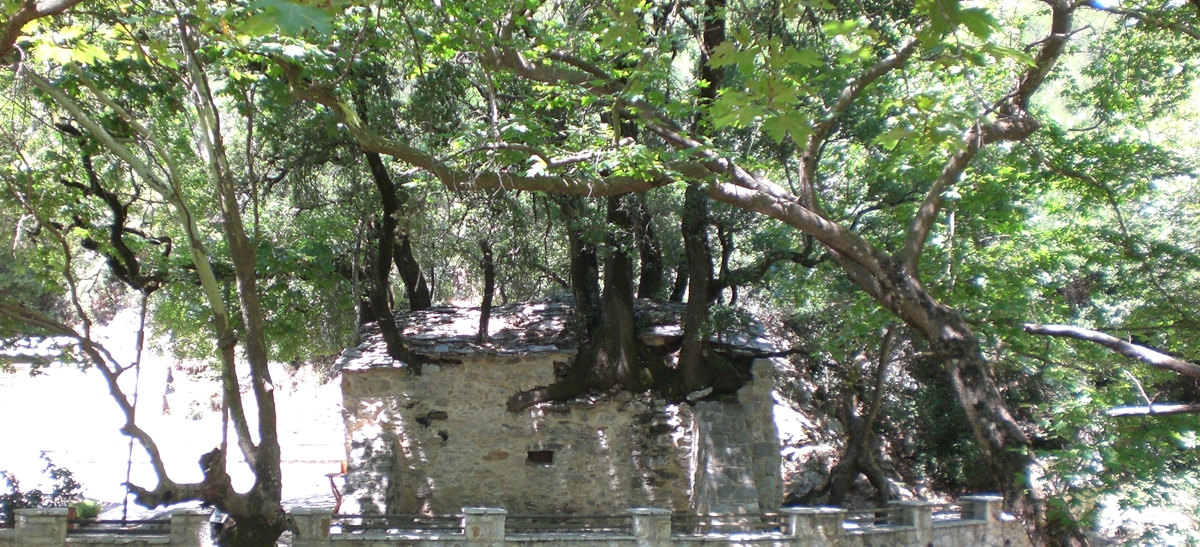AGIA THEODORA

PLEASE NOTE THAT ALL THE PHOTOGRAPHS ON THE SITE ARE CLICKABLE LINKS

PLEASE NOTE THAT ALL THE PHOTOGRAPHS ON THE SITE ARE CLICKABLE LINKS
The Church of Saint Theodora can be found just outside the village of Vasta near Megalopoli. It was built between the 10th and 12th centuries. According to tradition, the construction of the church is linked with the martyrdom of Theodora who was an 11th century Byzanite citizen born in the area of Ancient Melpeia.
When the area was raided by bandits, Theodora was determined to help defend her village, but as a woman she could not do so. Not to be deterred, Theodora secretly disguised herself as a male soldier in order to join the defence.
There are two versions of Theodora's demise. The first was that unfortunately, Theodora did not survive, and as she lay dying she spoke the following words: "Let my body become a church, my hair a forest of trees, and my blood a spring to water them."
The second was that as a soldier a woman developed lustful feelings for "Theodore"and claimed that he had impregnated her. Theodora was commanded to marry the woman or be condemned to death. Doing nothing to prove her innocence (as easy as this would be) Theodora placed her hope in God.
Being condemned to death, before her execution, she prayed, "Let my body become a church, my blood a river, and my hair the trees." On the spot where she was martyred, a spring gushed forth which flooded to become a river which still exists today.
Her faithful followers built a small church over her spot of martyrdom where soon 17 enormous trees (some weighing over 1 tonne) began growing in the roof of the church.
Although the roof of the chapel is thin, without any special reinforcement, it stands as if by miracle. The tree roots are not visible under the few centimeters thin roof either inside or outside the church.
The church is surrounded by a thick forest of oak plane trees and water streams and is close to river Charadro. A small river runs beneath the church and irrigates the trees. The building is five meters long and four meters wide.
The site has become important for Greek Orthodox pilgrims and sightseeing visitors alike. A religious miracle or a natural wonder?
For hundreds of years, the roots have not been visible. Locals could not find a scientific explanation for this phenomenon.
Many researchers have spent years studying the structure, even X-raying the walls, but had no explanation for the roots of the trees.
A research project to shed scientific light into the "miracle was launched in 1996. Scientists from the University of Patras tried to find out where the tree roots were grew. The geophysical team of the inspected the chapel and did scanning with special devices.
"After an onsite estimation of the situation it was decided that the high-frequency georadar would be used on the walls of the building together with electrical tomography with very small electrodes, so as to have a double check on the methodology," the scientists wrote in their official report.
The results of this investigation proved that the roots follow the gaps existing inside the stone wall of the church creating avenues between the stones and thus reaching the ground and the life-giving water.
The results of the investigation threw light on the mystery and gave the Direction of Restoration of Byzantine and After Byzantine Monuments all the answers they needed to proceed safely to the restoration of the Church of Saint Theodora.
It was proved that the roots follow the gaps existing inside the side stonewall creating repulsion stresses between the stones and thus they reach the ground.
This has led to the creation of a net of roots that reinforces the building from a static point of view opposing the roof load but also destroying the stonewalls.
It was also proved that the south wall is almost intact while there seems to be a particular void in the north wall.
Restoration works were carried out in 1998-1999, the restorers refrained from using injections with cement to avoid drying up the roots of the trees.
This ancient little church sits on the top of some huge unexplored caverns. About 40 years ago, a local land owner, Mitsios Papakostantinou, found three small statues in the unexplored caverns. The statues were claimed by the museum of Sparta.
Saint Theodora's feast day is on September the 11th when many people from across Greece will come to the church to pray.
The chapel continues to stand in its original position without any further damage, and the river running beneath keeps giving life to the trees .....